
This is intended to be a complete list of properties and districts listed on the National Register of Historic Places in Orleans County, New York. The locations of National Register properties and districts may be seen in a map by clicking on "Map of all coordinates". Two listings, the New York State Barge Canal and the Cobblestone Historic District, are further designated a National Historic Landmark.
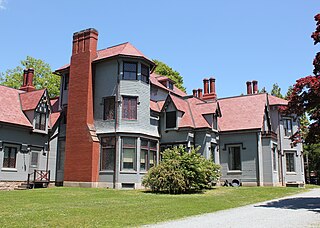
Kingscote is a Gothic Revival mansion and house museum at Bowery Street and Bellevue Avenue in Newport, Rhode Island, designed by Richard Upjohn and built in 1839. It was one of the first summer "cottages" constructed in Newport, and is now a National Historic Landmark. It was remodeled and extended by George Champlin Mason and later by Stanford White. It was owned by the King family from 1864 until 1972, when it was given to the Preservation Society of Newport County.

The Cooperstown Historic District is a national historic district in Cooperstown, Otsego County, New York, that was listed on the National Register of Historic Places in 1980. It encompasses 232 contributing properties: 226 contributing buildings, 1 contributing site, 3 contributing structures, and 2 contributing objects. Among the contributing properties is the village's post office, which is individually listed on the National Register.

Zion Church is a historic Episcopal church building located in Rome, Oneida County, New York. The church was designed by noted national church architect, Richard Upjohn, (1802-1878), built in 1850. It is a three-by-four-bay structure built of bluestone in the Gothic Revival style. Located adjacent is the stone "Clarke Memorial Hall" designed by local designer Frederick Hubbard and built a quarter-century later in 1884–1885.

The Downtown Albany Historic District is a 19-block, 66.6-acre (27.0 ha) area of Albany, New York, United States, centered on the junction of State and North and South Pearl streets. It is the oldest settled area of the city, originally planned and settled in the 17th century, and the nucleus of its later development and expansion. In 1980 it was designated a historic district by the city and then listed on the National Register of Historic Places.
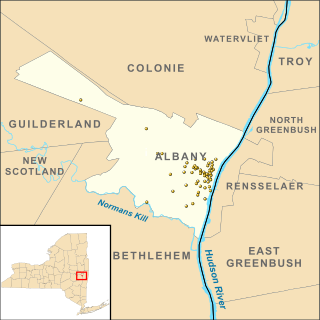
There are 75 properties listed on the National Register of Historic Places in Albany, New York, United States. Six are additionally designated as National Historic Landmarks (NHLs), the most of any city in the state after New York City. Another 14 are historic districts, for which 20 of the listings are also contributing properties. Two properties, both buildings, that had been listed in the past but have since been demolished have been delisted; one building that is also no longer extant remains listed.

St. Peter's Episcopal Church of Peekskill, New York, United States, is located on the north edge of the city's downtown. It is a three-building complex of stone Late Gothic Revival buildings on a half-acre dating to the late 19th century and added onto at successive later dates.
Genesee Park Historic District is a national historic district located at Geneva in Ontario County, New York. The district contains 16 contributing properties including 14 contributing buildings, one contributing site, and one contributing object. The focal point is Genesee Park, an informally landscaped village green. The district includes a remarkably intact collection of mid- to late-19th century civic, domestic, and religious properties. There are two notable churches: the massive St. Peter's Episcopal Church (1868), designed by Richard Upjohn, and the former North Presbyterian Church (1875), both examples of the Gothic Revival style.
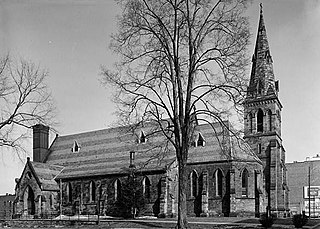
Christ Church is a historic Episcopal church located at Binghamton in Broome County, New York. It is a one-story bluestone structure with Gothic Revival elements. The church consists of a rectangular central section housing the nave and aisles, an apse and bell tower on the east facade, and side entrances through transepts on the north and south elevations. It was built between 1853 and 1855 and was designed by noted church architect Richard Upjohn, (1802-1878).

The Manlius Village Historic District is a 15-acre (6.1 ha) historic district on the east side of the Village of Manlius, in the Town of Manlius, New York, about 9.5 miles from the downtown of Syracuse.

New Stone Hall is a historic school building located at Franklin in Delaware County, New York, United States. It was built in 1855–1856 and is a three-story rectangular building, eight bays wide and three bays deep. It features a slate-covered hipped roof and octagonal cupola. It was built as the main academic building of the Delaware Literary Institute, then later used by the local school system. It was abandoned in 1932. It is located within the Franklin Village Historic District.
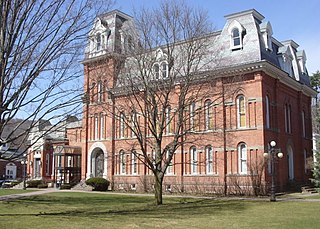
Delaware County Courthouse Square District is a national historic district located at Delhi in Delaware County, New York. The district contains 18 contributing buildings and one contributing structure. It consists of a distinctive and unspoiled grouping of 19th century governmental, commercial, and religious structures built around the village green. It includes the county courthouse and clerk's office, the local New York State DMV, several county department offices, and a bandstand. It also includes the buildings surrounding the green. The 2+1⁄2-story brick courthouse building was designed by Isaac G. Perry and features a mansard roof. Also within the district are the Presbyterian church (1831) and Bank building (1838).

Main Street Historic District is a national historic district located at Roxbury in Delaware County, New York. The district contains 86 contributing buildings, three contributing sites, three contributing structures, and one contributing object. The southern end of the district is dominated by the Gothic Revival style Jay Gould Memorial Reformed Church (1892), the Roxbury Central School (1939), and the Kirkside estate. Located nearby is a Greek Revival style Methodist church erected in 1858. Financier Jay Gould was raised nearby and in the 1890s began an interest in the development of Roxbury.

New Berlin Historic District is a national historic district located at New Berlin in Chenango County, New York. The district includes 118 contributing buildings. It encompasses the village's historic core and includes commercial, residential, civic, ecclesiastical, and railroad related buildings. Among the notable buildings are the Central Hotel, National Bank and Trust Building, First Baptist Church (1840), St. Andrew's Episcopal Church, Municipal Building, and New Berlin Central High School. Also located within the district is the separately listed Horace O. Moss House.
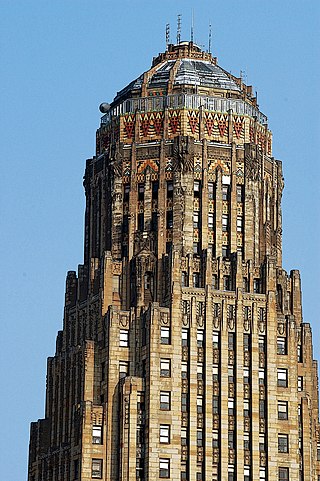
The Architecture of Buffalo, New York, particularly the buildings constructed between the American Civil War and the Great Depression, is said to have created a new, distinctly American form of architecture and to have influenced design throughout the world.

St. Thomas Episcopal Church is a historic Episcopal church located at 21 South Main Street in Newark, New Castle County, Delaware. It was built in 1843–45 and designed by noted architect Richard Upjohn. It is a one-story, three bay wide brick structure built of brick with stucco facing and a gable roof. It features a 35-foot entrance tower, added in 1866, and is in the Gothic Revival style. In 1956 the building was deconsecrated when the parish moved to a larger church. It has since been bought, restored, and renovated by the University of Delaware, installing a 1,234 pipe organ in the process. The building is now used as a music recital and event hall by the university.

The Downtown Athens Historic District is a historic area in the Downtown Athens neighborhood of Athens, Georgia. It was listed on the National Register of Historic Places in 1978. Its boundaries were revised twice, in 1984 and 2006, and additional documentation was filed in 2006.

The Cobble Hill Historic District is a municipal and national historic district located in the Cobble Hill neighborhood of Brooklyn, New York City. The national district consists of 796 contributing, largely residential buildings built between the 1830s and 1920s. It includes fine examples of Greek Revival, Italianate, and Queen Anne style row houses. Also in the district are a number of notable churches, including ones by Richard Upjohn and Minard Lafever, 1851–52). A number of early 20th century apartment buildings are part of the district as well.

The Burlington Historic District in Burlington, New Jersey, United States, is a historic district bounded by the Delaware River and High, West Broad, Talbot, and Reed streets; it is listed on state and federal registers of historic places. The oldest building in Burlington County and one of the oldest residences in New Jersey, the Revell House, is a contributing property. St. Mary's Episcopal Church, built in 1703 and the oldest church in New Jersey, is also within the district; the new St. Mary's, designed by Richard Upjohn and completed in 1854, has separate status as a National Historic Landmark. This district is adjacent to the city's High Street Historic District.

The Blackwell Street Historic District is a 25-acre (10 ha) historic district along Blackwell, Dickerson, Sussex, Bergen, Essex, Morris, Warren, Prospect and Dewey streets in the town of Dover in Morris County, New Jersey. It was added to the National Register of Historic Places on May 21, 1982, for its significance in architecture, commerce, education, performing arts, religion, and transportation.


























